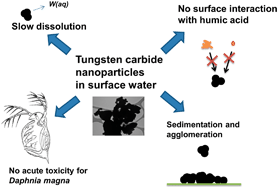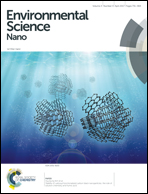Tungsten carbide nanoparticles in simulated surface water with natural organic matter: dissolution, agglomeration, sedimentation and interaction with Daphnia magna
Abstract
Even though anthropogenic nano-sized tungsten carbide nanoparticles (WC NPs) have been found in the environment, there are currently no investigations on their environmental fate. This work studies the interaction between natural organic matter (NOM) and WC NPs, as well as the potential uptake by the aquatic model organism Daphnia magna. We here show that the affinity between WC NPs and humic acid or dihydroxybenzoic acid (DHBA), which are model molecules of NOM, is very low with no observed surface adsorption. The lack of a stabilizing effect of these organic molecules, in combination with a relatively high effective density of WC NP agglomerates in humic acid, resulted in the substantial agglomeration and sedimentation of the WC NPs. A higher stability of the smaller sized WC NP agglomerates (<150 nm) means that this fraction is mobile and can be transported to other settings, suggesting that this particle fraction should be considered in further studies. The dissolution of tungsten from WC NPs was continuous and the relatively slow dissolution rate (on the order of 0.03 mg m−2 h−1) implies that particle transport will not be severely limited from a dissolution perspective. Uptake of tungsten (dissolved tungsten and WC particles) by D. magna was observed although this did not induce any acute toxic effects.



 Please wait while we load your content...
Please wait while we load your content...